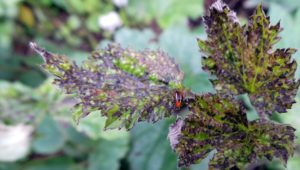Four-Lined Plant Bug Emerges as Troublesome Pest in Pennsylvania
 Growers in Pennsylvania are dealing with a particularly troublesome pest this spring.
Growers in Pennsylvania are dealing with a particularly troublesome pest this spring.
The four-lined plant bugs (Poecilocapsus lineatus) is one of the few pests that injure a wide variety of plants, including herbs that are rarely bothered by anything else, according to Sandy Feather, Extension Educator at Penn State University. Other plants that often sustain damage from this pest include shasta daisies, Russian sage, and blue-mist shrub, as well as the new growth of many shrubs, such as forsythia, deutzia, dogwood, and weigela. Consumers may quickly notice this damage in their herb and flower gardens.
Four-lined plant bug damage is very characteristic: circular brown to black spots about one-sixteenth of an inch in diameter. The spots often coalesce to create a more blotchy appearance that could easily be mistaken for some kind of disease, or possibly frost damage. These shy insects move very rapidly and are often difficult to see.
Four-lined plant bugs overwinter as eggs lain in the twigs of woody plants during the previous growing season. Females cut a slit in the new growth and lay their eggs while it is still tender. The eggs hatch in the following spring at about the same time as forsythia leaves begin to unfold. They generally feed on tender new growth with their piercing-sucking mouthparts. They extract the chlorophyll as they feed, and also inject enzymes, which results in the characteristic spots. As the growing season progresses, the damaged areas often drop out, leaving holes in the leaves of affected plants.
Four-lined plant bugs feed for about six weeks in May and June. Adults die once they mate and lay eggs for next year’s generation, so you will not see more damage from them until next year.
Adult four-lined plant bugs are yellowish-green with four black stripes. They are about one-quarter of an inch long. The smaller nymphs range from bright red to yellow. The black lines on the nymphs do not extend all the way down their bodies because their wing covers are not fully developed until they molt into adults. Both nymphs and adults create damage as they feed.
Although the damage four-lined plant bugs cause is unsightly, it is not generally life threatening to affected plants. On herbaceous plants such as herbs and perennial flowers, one of the easiest ways to deal with the damage is to wait until the pests have gone for the year, and then cut the plants back below the damage. They will regrow nicely, and no one will ever know how bad they looked in spring. This treatment can delay blooming of herbaceous perennials a bit.
If your customers are intolerant of damage, begin making applications at the first sign of their activity, because just a few of these pests can create a lot of damage. Also, nymphs are easier to control than the adults. Insecticides labeled to control four-lined plant bugs on woody ornamentals include acetamiprid, bifenthrin, carbaryl, cyfluthrin, flonicamid, insecticidal soap, lambda-cyhalothrin, malathion, permethrin, pyrethrins and piperonyl butoxide, and thiamethoxam.









